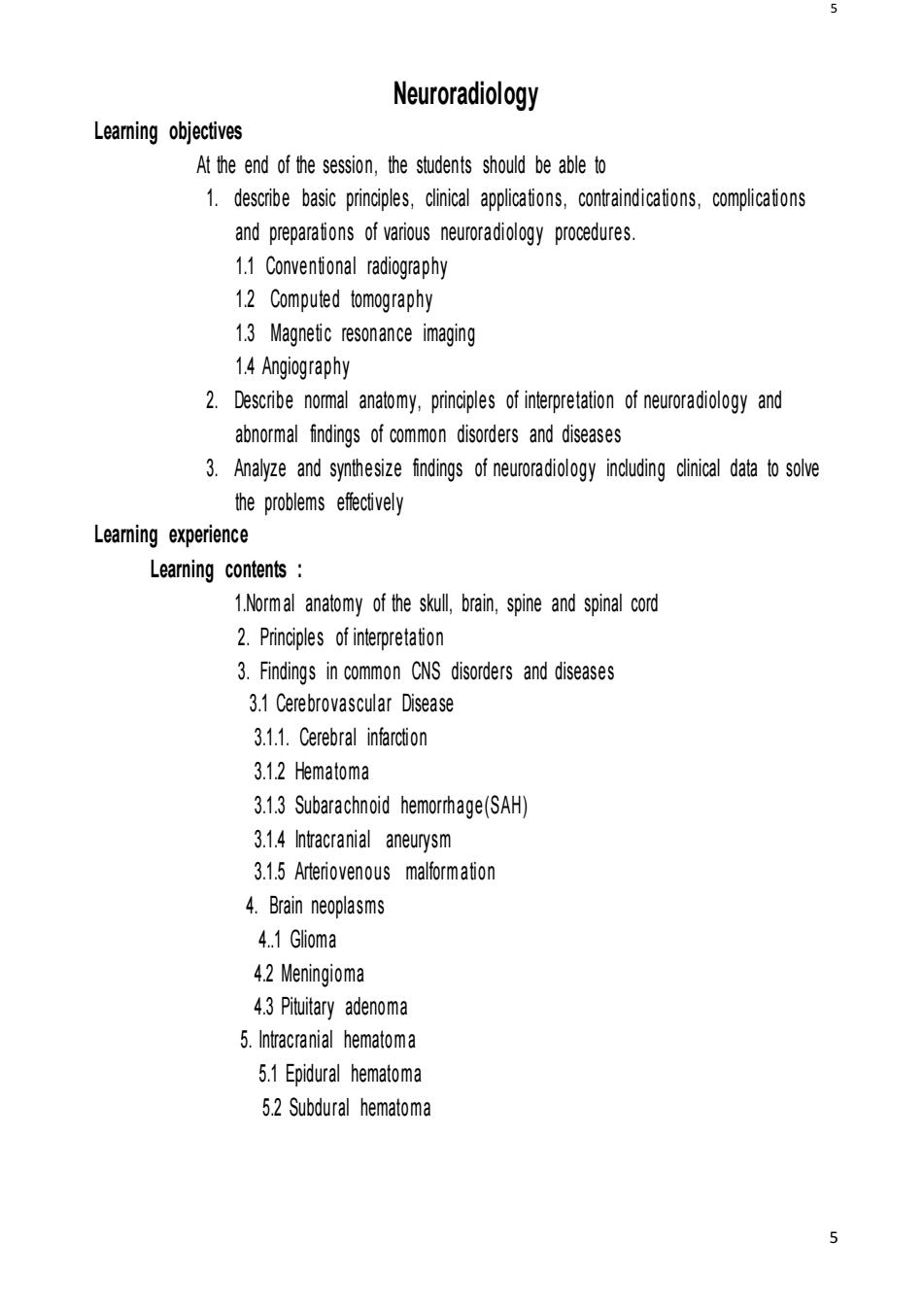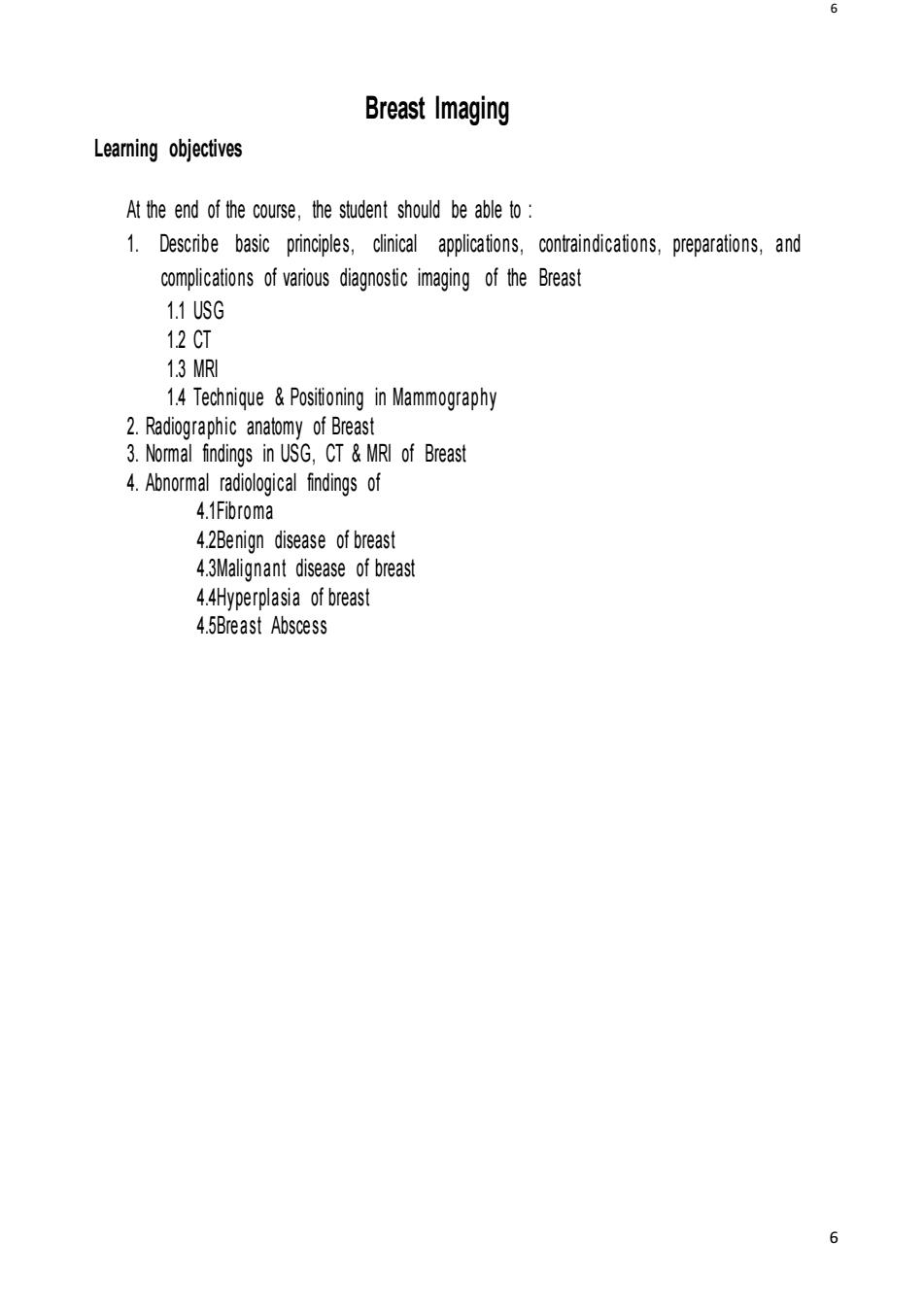
Neuroradiology Learning objectives At the end of the session,the students should be able to 1.dscibe basic principslincappiciraindicmi and preparations of various neuroradiology procedures. 1.1 Conventional radiography 1.2 Computed tomography 1.3 Magnetic resonance imaging 1.4 Angiography 2.Describe normal anatomy,principles of interpretation of neuroradiology and abnormal findings of common disorders and diseases 3.Analyze and synthesize findings of neuroradiology including clinical data to solve the problems effectively Leamning experience Learning contents 1.Normal anatomy of the skull,brain,spine and spinal cord 2.Principles of interpretation 3.Findings in comm CNS disorders and diseases 3.1 Cerebrovascular Disease 3.1.1.Cerebral infarction 3.1.2 Hematoma 3.1.3 Subarachnoid hemorrhage(SAH 3.1.4 Intracranial aneurysm 3.1.5 Arteriovenous malformation 4.Brain neoplasms 4.1 Glioma 4.2 Meningioma 4.3 Pituitary adenoma 5.Intracranial hematoma 5.1 Epidural hematoma 5.2 Subdural hematoma
5 5 Neuroradiology Learning objectives At the end of the session, the students should be able to 1. describe basic principles, clinical applications, contraindications, complications and preparations of various neuroradiology procedures. 1.1 Conventional radiography 1.2 Computed tomography 1.3 Magnetic resonance imaging 1.4 Angiography 2. Describe normal anatomy, principles of interpretation of neuroradiology and abnormal findings of common disorders and diseases 3. Analyze and synthesize findings of neuroradiology including clinical data to solve the problems effectively Learning experience Learning contents : 1.Norm al anatomy of the skull, brain, spine and spinal cord 2. Principles of interpretation 3. Findings in common CNS disorders and diseases 3.1 Cerebrovascular Disease 3.1.1. Cerebral infarction 3.1.2 Hematoma 3.1.3 Subarachnoid hemorrhage(SAH) 3.1.4 Intracranial aneurysm 3.1.5 Arteriovenous malform ation 4. Brain neoplasms 4.1 Glioma 4.2 Meningioma 4.3 Pituitary adenoma 5. Intracranial hematom a 5.1 Epidural hematoma 5.2 Subdural hematoma

Breast Imaging Learning objectives At the end of the course,the student should be able to 1.Describe basic principles,clinical applications,conraindicins,preparations.and complications of various diagnostic imaging of the Breast 1.1 USG 12 CT 1.3 MRI 1.4 Technique&Positioning in Mammography 2.Radiographic anatomy of Breast 3.Normal findings in USG,CT MRI of Breast 4.Abnormal radioogical findings of 4.1Fibroma 4.2Benign disease of breast 4.3Malignant disease of breast 4.4Hyperplasia of breast 4.5Breast Abscess
6 6 Breast Imaging Learning objectives At the end of the course, the student should be able to : 1. Describe basic principles, clinical applications, contraindications, preparations, and complications of various diagnostic imaging of the Breast 1.1 USG 1.2 CT 1.3 MRI 1.4 Technique & Positioning in Mammography 2. Radiographic anatomy of Breast 3. Normal findings in USG, CT & MRI of Breast 4. Abnormal radiological findings of 4.1Fibroma 4.2Benign disease of breast 4.3Malignant disease of breast 4.4Hyperplasia of breast 4.5Breast Abscess